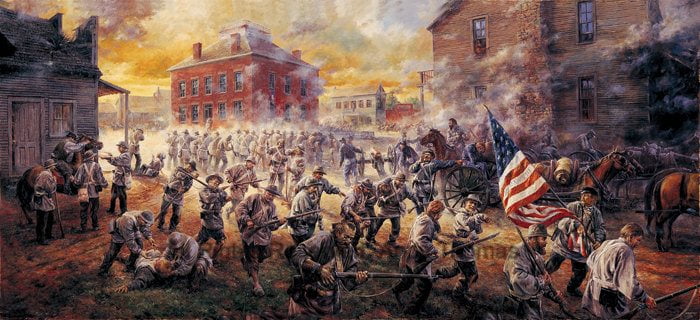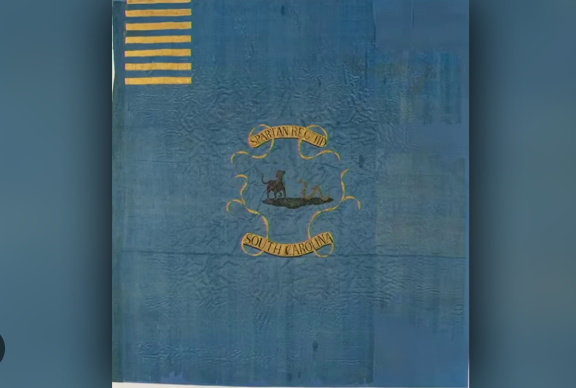MISSOURI — Battle of Carthage Re-Enactment Set
CARTHAGE, Mo. — On July 5, 1861, the quiet prairie and farmland around the tiny community of Carthage was rocked by the sounds of cannon, muskets, soldiers yelling and horses galloping in what many say was the first real battle of the Civil War.
Taking place almost three weeks before Virginia’s Battle of Bull Run, which history books typically call the first Civil War conflict, the Battle of Carthage saw 1,100 Union troops from St. Louis, led by Col. Franz Sigel, engage more than 6,000 Missouri State Guard soldiers, led by Missouri Gov. Claiborne Fox Jackson in a daylong running fight.
On Saturday and Sunday, May 21-22, Carthage residents and Civil War enthusiasts from across the country will gather on a small part of the original battlefield at the Civil War Ranch and Arena north of Carthage to recognize the battle and those who fought on both sides.
Battle of Carthage Inc., the city of Carthage, Vision Carthage and the Carthage Chamber of Commerce will host a Civil War reenactment to mark the 160th anniversary of the battle. The event had originally been planned for last year, but the COVID-19 pandemic forced its postponement, according to organizer and author Steve Cottrell.
“We’re not doing it through town like we did during the last big reenactment in 2011,” Cottrell said. “This one will be at the Civil War Ranch and Arena … north of Carthage at 11831 Civil War Road. We’ve done it out there a couple of times in the past, and it’s really perfect for doing that. The public will have a great viewing area, and the reenactors will have a wonderful field on which to portray the battle.”
This year’s event will include vendors and displays on another key part of the original battlefield, the Carthage square.
The Carthage Chamber of Commerce is still seeking vendors for the Civil War Day event scheduled for 10 a.m. to 5 p.m. Saturday, May 21, on the square.
“With all of the activities going on outside of town, we wanted to create a fun downtown event that the visitors coming to our area could come and locally shop, eat, and explore all the fun things to do while they are in Carthage,” said Julie Reams, president of the Carthage Chamber of Commerce. “We are excited that we can bring a fun family event to the downtown area to the visitors and also to the community. We are looking for crafters, any period piece vendors or those that want to do any demonstrations on our beautiful square.”
Big battlefield
The site where the Battle of Carthage was fought is not like those such as Wilson’s Creek National Battlefield in Springfield or Pea Ridge National Battlefield in Northwest Arkansas.
In those cases, armies of similar numbers met in open areas and battled for supremacy, with the winners remaining and the losers retreating.
Cottrell said the Battle of Carthage was a running fight that lasted the entire day of July 5, 1861, because both sides quickly realized one side vastly outnumbered the other and the smaller force fought delaying actions at key locations to prevent the larger one from cutting it off from retreat.
Sigel’s Union troops came to Carthage on late in the day July 4 and set up camp east of Carthage where the Battle of Carthage State Historic Site and Carter Park on east Chestnut Avenue are now.
They awoke early the next morning, broke camp and marched through Carthage and then north on what was then a wagon trail called the Carthage-Lamar road, which runs roughly the route now followed by Civil War Road.
The Missouri State Guard forces, which had been routed from Jefferson City the month before and were fleeing a much larger Union force led by Gen. Nathaniel Lyon, had camped the previous night in Lamar and was marching to Arkansas to join the Confederate army there.
They marched south, and the two armies met at the spot where Civil War Road and Baseline Road intersect about 9 miles north of Carthage.
What followed was a textbook fighting retreat by the well-trained Union forces, numbering 1,100 and composed mostly of German veterans of wars in Europe, and a pursuit by the mostly untrained and only partially armed Missouri State Guard, composed of about 6,000 recent recruits.
The Union forces held off repeated attempts to surround them and capture their wagon train of supplies as it retreated south toward Carthage.
The fight included engagements at creek crossings at Buck’s Branch and Dry Fork, and it culminated in a firefight in Carthage and around the original brick courthouse and wood-framed buildings that made up the square at the time.
It ended with Union artillery holding off the guard troops at sunset near where Union forces camped the night before.
Union soldiers continued marching through the night of July 5-6 to Sarcoxie before they rested while the Missouri State Guard troops bedded down for the night in the same campsite where Sigel’s troops slept July 4.
Reenactment
Now nearly the entire battlefield is private land, and except for the limestone quarries north of Carthage, the battlefield north of town is nearly as it appeared in 1861.
Cottrell said holding a reenactment on the original battlefield is something special for Civil War enthusiasts.
“That frequently does not happen with reenactments because the National Park Service has a rule against it,” Cottrell said. “The state parks have allowed it from time to time on the real battlefield, but the national parks never allow it.”
He added: “It’s always special. Everyone feels a little different when they’re on the actual battlefield rather than removed from where it actually happens. There’s something spiritual that I can’t quite describe totally. It’s a different feeling to be right where the real guys were when their traumatic experience happened. Also it’s humbling and adds a little extra serious reverence to it.”
Cottrell said he expected as many as 700 reenactors to attend and camp overnight at the Civil War Ranch, giving residents a chance to see what life was like in an 1860s-era soldiers’ camp.
“Some people think the battle is the main deal, which it kind of is, but there’s a lot of other things that happen during a reenactment,” Cottrell said. “A lot of the reenactment involves being able to tour the camps, and everyone’s welcome to do that. The only fee you’ll have to pay is a parking fee of $5 per car whether you have 10 people in a car or one person.”
–joplinglobe.com



